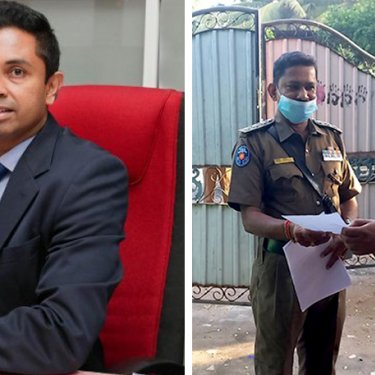Armed attack on well-known Sri Lankan TV journalist’s home

Reporters Without Borders (RSF) calls for an independent investigation into an attack by armed men on the home of well-known Sri Lankan TV journalist Chamuditha Samarawickrama after he received death threats linked to his work. Those responsible for this punitive raid must be identified, and the authorities must end all forms of harassment of journalists, RSF says.
After a loud noise woke Chamuditha Samarawickrama at around 2:10 a.m. on 14 February, he heard shots being fired in his direction. He later found that the shots had shattered some of the windows of his home and that faeces had been thrown at walls.
Surveillance camera footage showed that at least four masked gunmen stormed his home in Piliyandala, a suburb of the Sri Lankan capital, Colombo. To get into the compound, they threatened his guard by putting a gun to his temple, and afterwards they left in the white van in which they had arrived.
The police have not established the motive for the attack but Samarawickrama had recently reported receiving several death threats on his phone in connection with his work,
The host of two Hiru TV shows, “Salakuna” and “Patthare Wisthare,” Samarawickrama also conducts interviews on his own YouTube channel called “Truth with Chamuditha.” In a recent interview, a former police officer who has obtained asylum in Britain criticised the methods used by the Rajapaksa family, one of whose members, Gotabaya Rajapaksa, is the current president.
Reminder of most repressive period
Secretary to the ministry of Defence when his brother, Mahinda Rajapaksa, was president from 2005 to 2015, Gotabaya Rajapaksa was known then as the head of the “white van gang” because of the vehicles this unit used to kidnap and kill journalists. At least 14 journalists disappeared after being taken away in the notorious white vans, which were similar in every way to the van used in this week’s raid on Samarawickrama’s home.
“The modus operandi used in this attack on Chamuditha Samarawickrama recalls the height of the persecution of Sri Lankan journalists,” said Daniel Bastard. “The perpetrators and instigators of this unacceptable act of intimidation must be identified and prosecuted. We urge the government to end all forms of harassment of the country’s journalists.”
The attack on Samarawickrama has prompted outrage in mainstream media outlets serving Sri Lanka’s Sinhalese majority, who live in the south of the island. Journalists based in the north and east, where the Tamil and/or Muslim minorities live, are also constantly subjected to physical and judicial harassment by the authorities.
Pressured to name sources
In the eastern city of Batticaloa, for example, a court ordered Punniyamoorthy Sasikaran, a journalist who is also the city’s press club treasurer, to remain at home on 4 February on the pretext of preventing him from covering a “banned protest” that was never planned and did not take place. Since mid-2021, Sasikaran has been repeatedly questioned by the Batticaloa police special crime branch and pressured to reveal his sources.
When another Tamil minority journalist, Selvakumar Nilanthan, was questioned by members of the Batticaloa terrorism investigation division last July, he was pressured to hand over the passwords that would give them access to his messaging services and bank accounts.
In January 2021, RSF revealed that the authorities in Batticaloa were still holding Murugupillai Kokulathasan, a freelance journalist who had been arrested in the utmost secrecy on a terrorism charge the previous November.
Sri Lanka is ranked 127th out of 180 countries in RSF's 2021 World Press Freedom Index.



